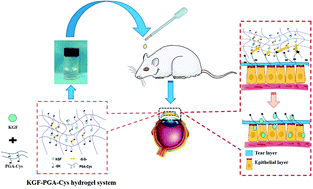Thiolated γ-polyglutamic acid as a bioadhesive hydrogel-forming material: evaluation of gelation, bioadhesive properties and sustained release of KGF in the repair of injured corneas†
Abstract
Keratinocyte growth factor (KGF) has a good therapeutic effect on injured corneas. However, due to the washout of tears and blinking, locally administrated KGF usually has a short residence time on the surface of an injured cornea, resulting in its poor bioavailability. Herein, a bioadhesive hydrogel is described produced using cysteine-modified γ-polyglutamic acid (PGA-Cys) as the hydrogel-forming material to locally deliver KGF. A series of PGA-Cys polymers with different graft ratios of cysteine were firstly synthesized and carefully characterized. Thereafter, the PGA-Cys hydrogel was screened by changing the graft ratio of cysteine and polymer concentration, and the apparent viscosities and bioadhesive force were also carefully investigated. It was found that PGA-Cys polymers with different graft ratios of cysteine exhibited tunable apparent viscosity and bioadhesive properties at the same polymer concentration. When PGA-Cys with a graft ratio of 1.5 mmol g−1 of cysteine (PGA-Cys-1.5) was used as hydrogel-forming material, the hydrogel exhibited a good gelation property with an apparent viscosity of 5.2 Pa s and strong bioadhesive force of 167 ± 0.5 mN. In vitro release study showed that KGF was slowly released from PGA-Cys-1.5 hydrogel over a longer time in comparison to PGA solution alone. Moreover, PGA-Cys-1.5 hydrogel enabled most of the encapsulated KGF to be retained on the cornea and conjunctiva after local administration. Meanwhile, the morphology of the corneal epithelium in the alkali-injured cornea of mice was well repaired after 7 days of treatment with KGF-PGA-Cys-1.5 hydrogel. The therapeutic mechanism was strongly associated with inhibiting corneal inflammation and neovascularization, promoting proliferation of the corneal epithelium and inhibiting apoptosis. Overall, the use of the bioadhesive PGA-Cys hydrogel with a suitable KGF release profile may be a more promising approach than using PGA solution alone and KGF to repair injured corneas.



 Please wait while we load your content...
Please wait while we load your content...